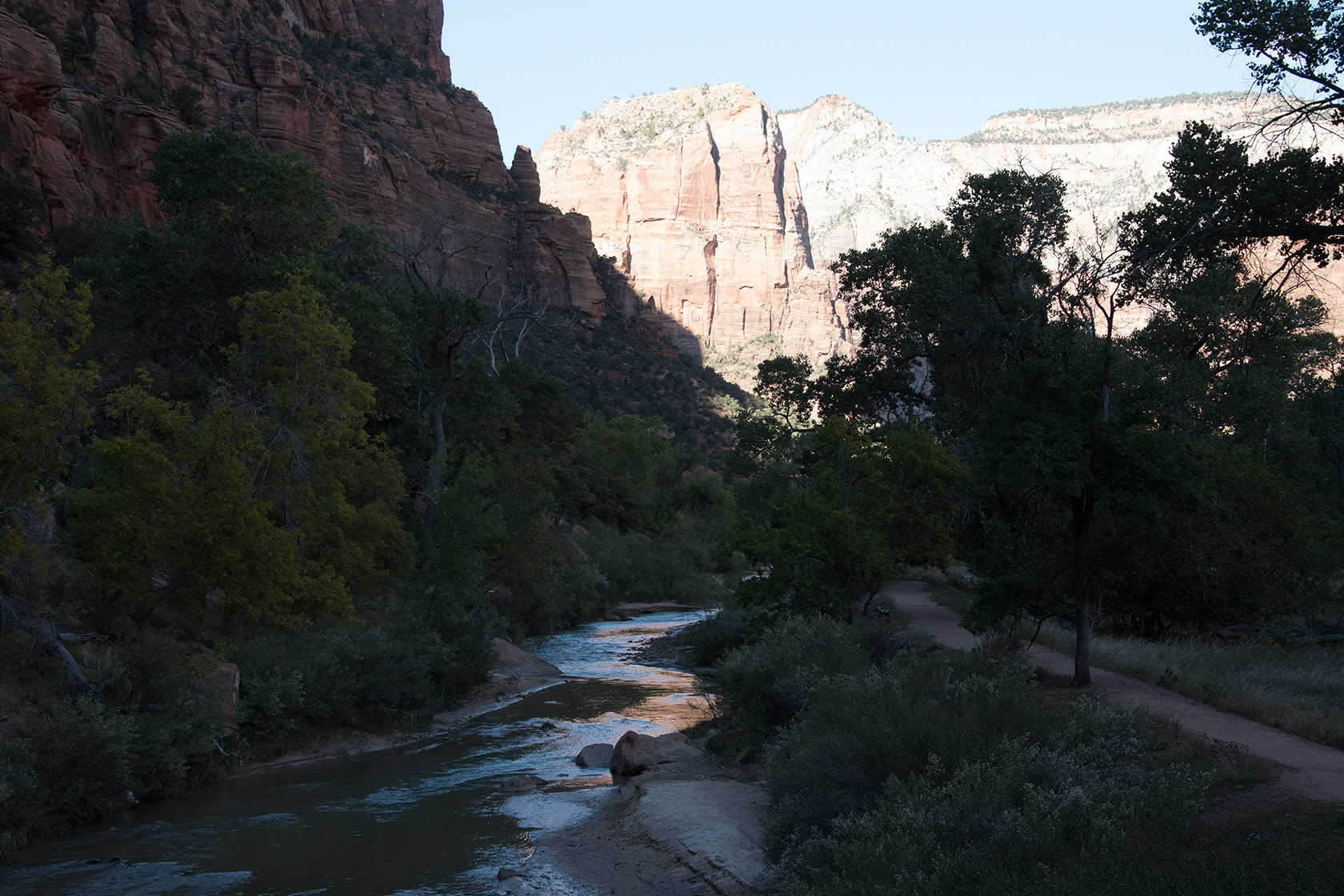
Nikon D750 28-300mm f/3.5-5.6 lens @ 58mm f/8 1/250 ISO 400 RAW
Post processing is a term used to describe the manipulation of photographs on a personal computer by means of software developed for that purpose. For some reason, many people consider this a form of cheating, an unacceptable way of obtaining a look that, in their view, should have been achieved while taking the picture. I couldn't disagree more. I believe post processing digital images is essential; in the following, I shall try to explain why and illustrate the point with a few examples. To begin with, we must distinguish between several types of post processing:
1. Adjusting Image Parameters
Here, we are concerned with luminosity, color balance, contrast, sharpening, and things of that nature. In the analog photography days, most people would send in their exposed film to a lab that would process it and, more often than not, produce prints. During exposure, the only parameter taken into account was the light level, measured either by averaging the light intensities across the frame, by spot metering or by some other algorithm developed by the camera manufacturer. No matter what the method was, a single exposure was obviously used for both the lightest and darkest parts of the image.
Those who made their own black and white prints in a darkroom, as I did, had some control. They could affect contrast by using harder or softer paper, and they could dodge and burn to mitigate the underexposure of the darkest parts of the image and the overexposure of the brightest areas. In a lab that produced prints by machine, though, it was software that attempted to adjust contrast, luminosity, saturation, and white balance. In effect, this was a form of post processing, albeit not performed by the photographer.
With the advent of digital photography, this changed. Suddenly, labs were no longer needed: people could take pictures, transfer them to their computer, print them with a suitable printer, display them on screen, or publish them on the Internet.
A digital camera captures a scene by separating the colors red, green, and blue and storing the intensity of each value in a particular part of the sensor as a binary number. This enormous collection of ones and zeros, called raw sensor data, must then be converted to something that makes sense when viewed by humans. This is the job of the raw converter, usually part of the software inside the camera. It interprets the raw data and produces an 8-bit JPEG image, sometimes by taking user-defined criteria, such as saturation level, sharpness, contrast, white balance, and so on, into account. That too, constitutes a type of post processing, done in-camera before the picture is stored on whatever media is being used.
It is important to realize that once such processing has taken place and the JPEG file has been created, one is stuck with the adjustments that have been made. Of course, one could still adjust parameters to a certain extent by using photo-processing software, but only up to a point and not without incurring a loss of image quality. In a way, one is stuck by what the camera's software has made of the raw data, with or without user-specified parameters.
As time went by, more sophisticated cameras began to offer the possibility of storing the raw data. In this scenario, it is the sensor data itself that is being written to a file. The drawback is that it takes a great deal more space (in part because one does not benefit from the JPEG compression) and that one needs a raw converter other than the one built into the camera, but the advantage is that the photographer can now experiment with many different parameters in a non-destructive way and see which are most suitable for the image. In a way, a raw file is like having a negative from which many prints with different settings can be produced. Raw formats are typically 12-bit or 14-bit, and this tremendously increases the number of colors that can be represented compared with the 8-bit JPEG format. Post processing is even more important for photographs captured in a raw format because these don't even benefit from the often rudimentary processing of JPEG files. Consider the following example:
Click on any image to see a larger (2100 x 1400 pixel) version!

|
Nikon D750 28-300mm f/3.5-5.6 lens @ 58mm f/8 1/250 ISO 400 RAW |
This picture, shown here (like all the other "before" photographs converted from a raw file to a JPEG without any adjustments other than size), was taken in Zion National Park in Utah at around 4:30 p.m. in early October of 2016. It was already getting dark, so the light conditions were challenging; this caused the foreground to be underexposed whereas the rock wall in the background is clearly overexposed. A JPEG file of this scene might have yielded slightly better results, but only marginally so. This is the result of post processing the raw photo:
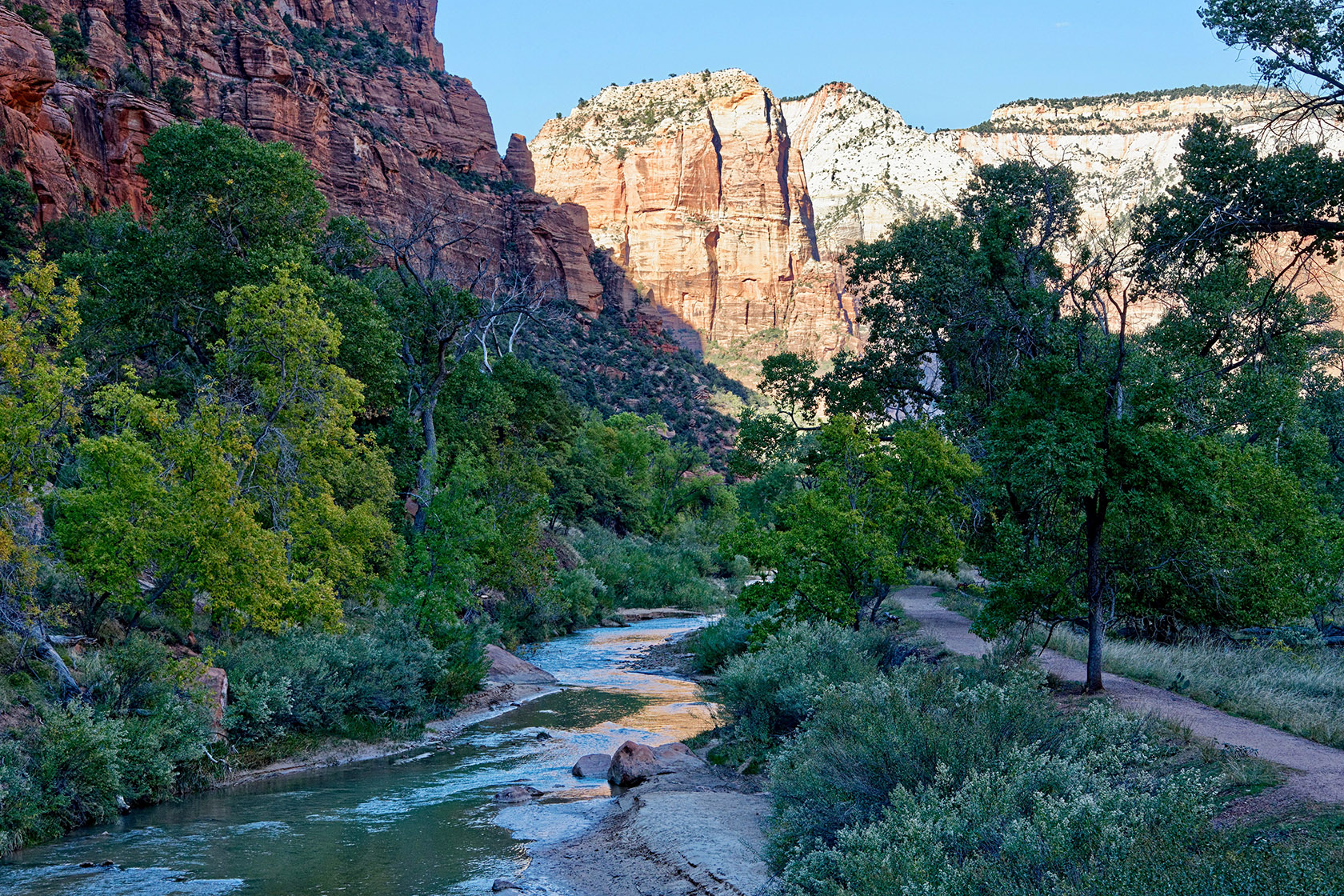
|
It would be absolutely impossible to obtain a result like this out of camera, that is, without post processing. Even the most conservative photographers would agree that such manipulation of raw images is indispensable. However, post processing is time-consuming and requires skills that are themselves time-consuming to acquire. The above example is rather basic and does not take much time to accomplish. Indeed, a post-processed JPEG file could have yielded similar (though not identical) results. This is the reason many professionals who are pressed for time shoot in JPEG. For instance, wedding photographers who shoot hundreds of images per event cannot invest the time to cull and process that many raw photos; they therefore resort to JPEG which requires them to nail exposure and white balance, but after all, they are professionals.
2. Creating a Mood
This type of post processing comes into play when we wish to tell a story, to create an impression that is different from what we can capture while photographing the scene. This can include converting a photo to black-and-white, adding grain, using vignettes (i.e., darkening corners and sides of an image), or enhancing, and even manipulating one or more colors. Here is an example of this kind of post processing:
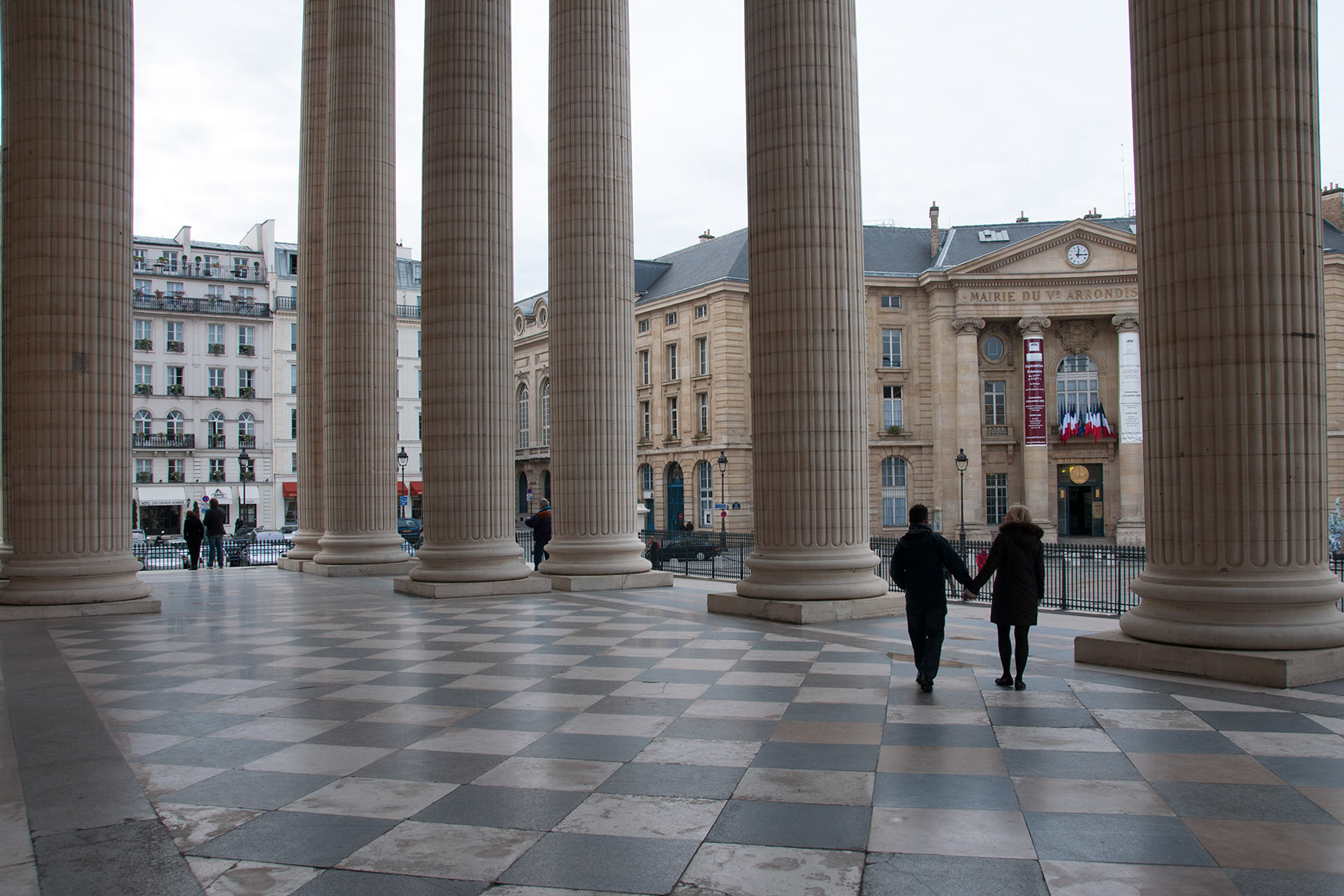
|
Nikon D300 18-200mm f/3.5-5.6 lens @ 20mm (30mm in 35mm equivalent) f/8 1/250 ISO 200 RAW |
This image was taken in November of 2009 as I was coming out of the Pantheon in Paris. The area around the columns, usually very crowded, was empty except for a young couple holding hands while walking in the direction of the mairie, city hall (in France, such basic symbolism requires no explanation). I raised the camera and released the shutter in one motion—thank goodness for fast autoexposure and autofocus technologies!
While I was happy with the result because everything I needed was there, the photo did not begin to express the mood I wished to convey, a mood that flashed into my mind as soon as I saw the scene. The columns are not straight (I shot at a slight wide-angle setting (30mm in full frame terms), so the verticals tend to converge), the color is anemic and adds nothing to the image, the sky is completely washed out and does not reveal any detail, in short, without post processing, this image would not be usable. I began by straightening the verticals, converting the photo to black-and-white and giving it the characteristics of a moderately grainy photo taken with Kodak Tri-X 400 film, adjusted contrast, added a bit of sharpening, and optimized the final image to be printed at 55 x 40 centimeters (roughly 16 x 21 inches).
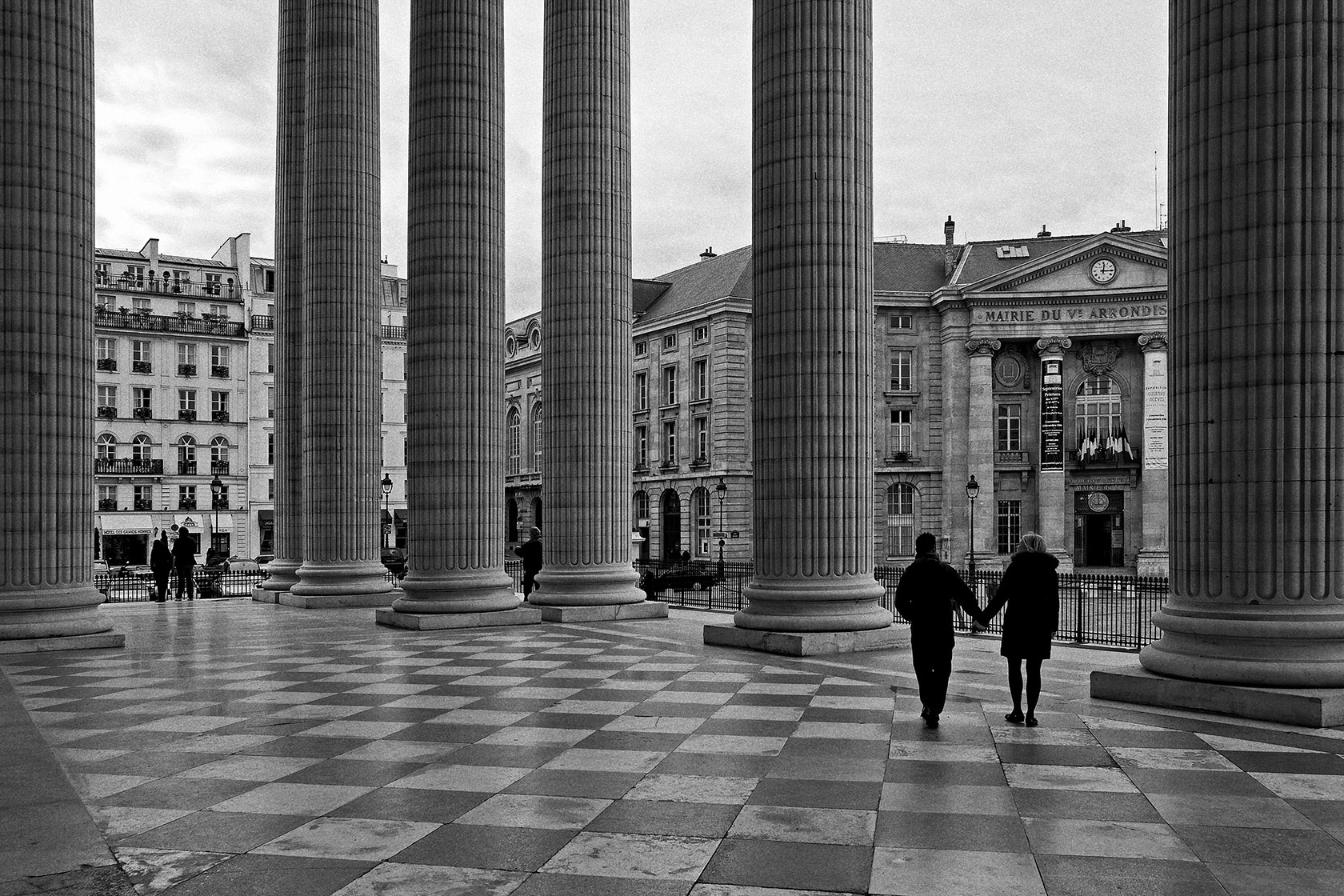
|
Even though one would have to stand in front of the actual print to fully appreciate the effect, it should already be obvious that the mood of the photograph is not in the least the same as what came out of the camera. Is this cheating? I don't think so. I wanted to tell a story, to produce a mood, and the processed photo corresponds exactly to what I wished to impart. After being displayed in my office at work for several years, the framed print now hangs in my home office in Chapel Hill.
For another example, let's look at an image I took at the Sachsenhausen concentration camp near Berlin in February of 2008. I shot through the main gate with its infamous inscription:
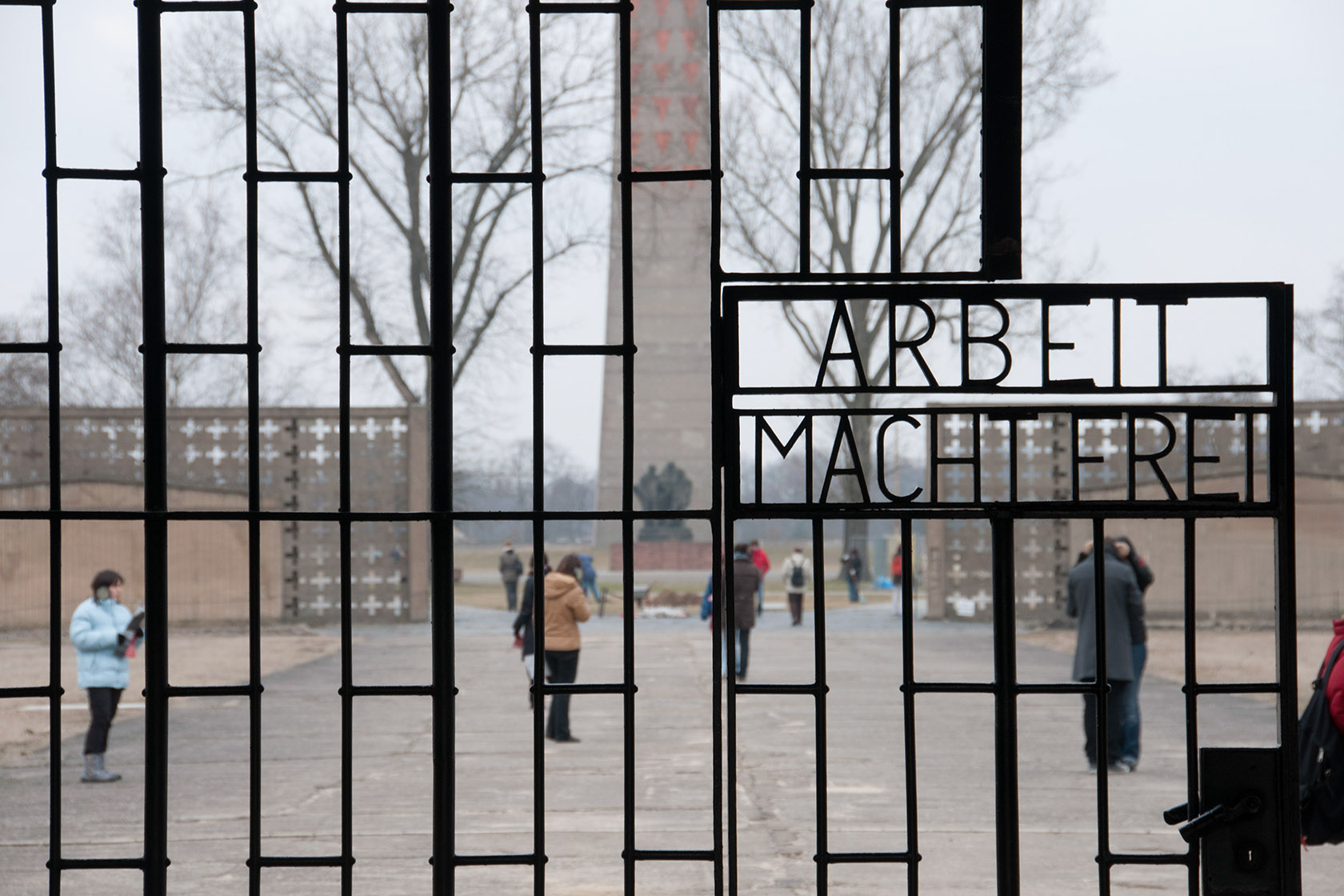
|
Nikon D300 18-200mm f/3.5-5.6 lens @ 95mm (124mm in 35mm equivalent) f/9 1/100 ISO 200 RAW |
It would be wrong to say that when I took the picture, I had the post-processed photo below in mind. I did, however, know what kind of mood and atmosphere I wanted to create. It had to be somewhat sinister, with grain so heavy that it would cause everything beyond the gate to become a bit fuzzy, and I wanted a gentle sepia color and a vignette to evoke age. The thing to remember here is that only post processing can do any of this. It would have been completely impossible to take this photo as it appears here. You have to start with an idea and then see how the photo you can take may be adapted to tell the story you wish to relate.
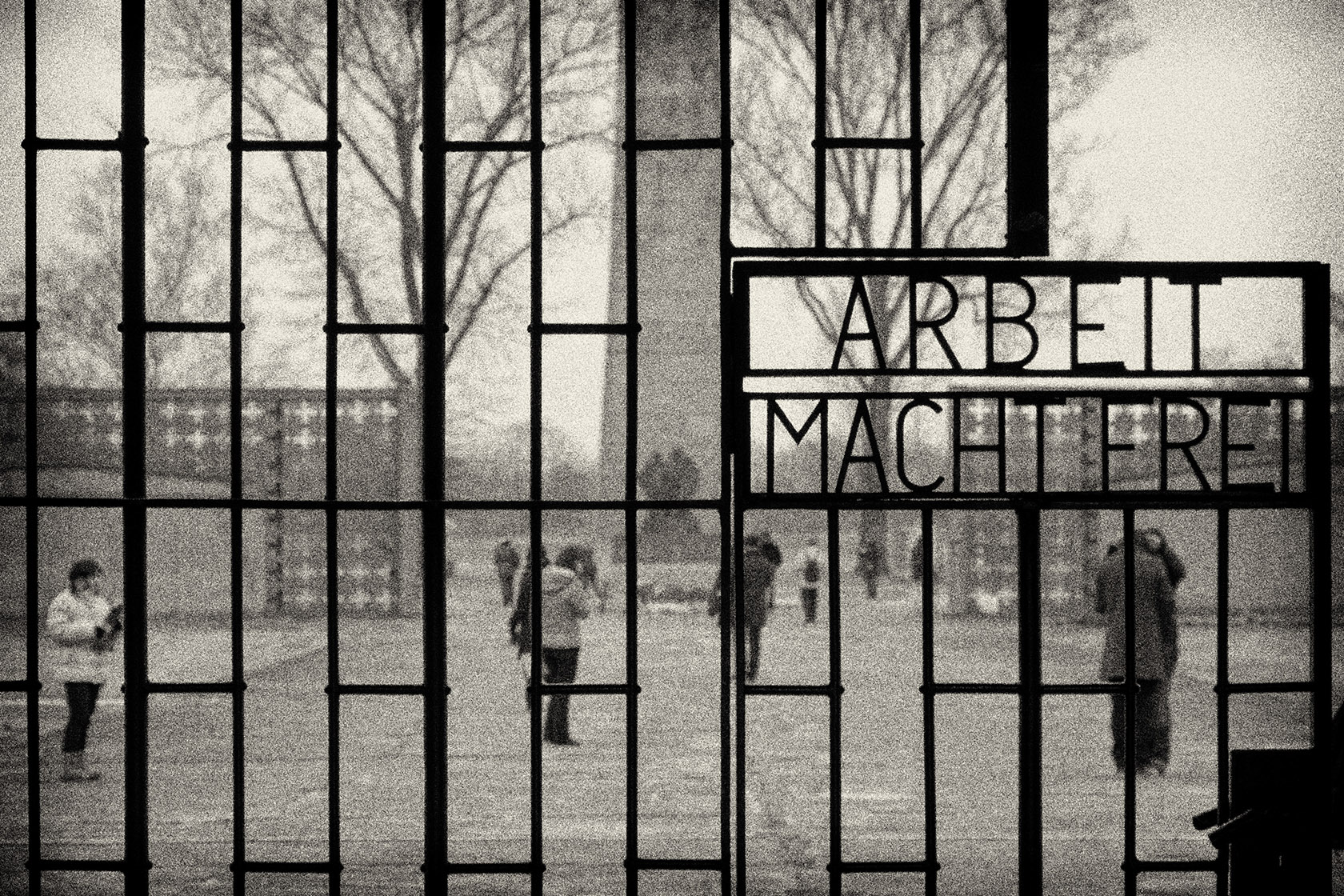
|
The purpose is not to depict the world exactly as it is, but rather to create an image that will trigger a certain response. Photographers can, but do not have to be documentarians!
3. Altering Reality
So far, we have seen post processing for the purpose of optimizing image parameters and creating different moods. The third category I wish to address is changing reality, most often by removing unwanted picture elements. This is by far the most controversial type of post processing; many people believe that for some reason, photographers must depict reality, and only reality. I disagree. In my view, photographers are not obliged to do anything in particular; they can use whatever technique they deem appropriate to show the viewer what they wish to present.
To be sure, such techniques can be abused. Pasting dozens of attendees into a photograph of a community meeting to make it seem that more than the three people who were actually present attended may be wrong if the image is to prove the alleged popularity of this particular meeting, but it is perfectly permissible if the photographer merely wishes to create an image that shows what a typical community meeting can or should be like.
We've all seen photos with power cables obstructing a beautiful façade, or of a tree seemingly growing out of someone's head. These imperfections can and should be removed as the photograph will be better for it. For example, consider the following image of Angel Oak on Johns Island in South Carolina:
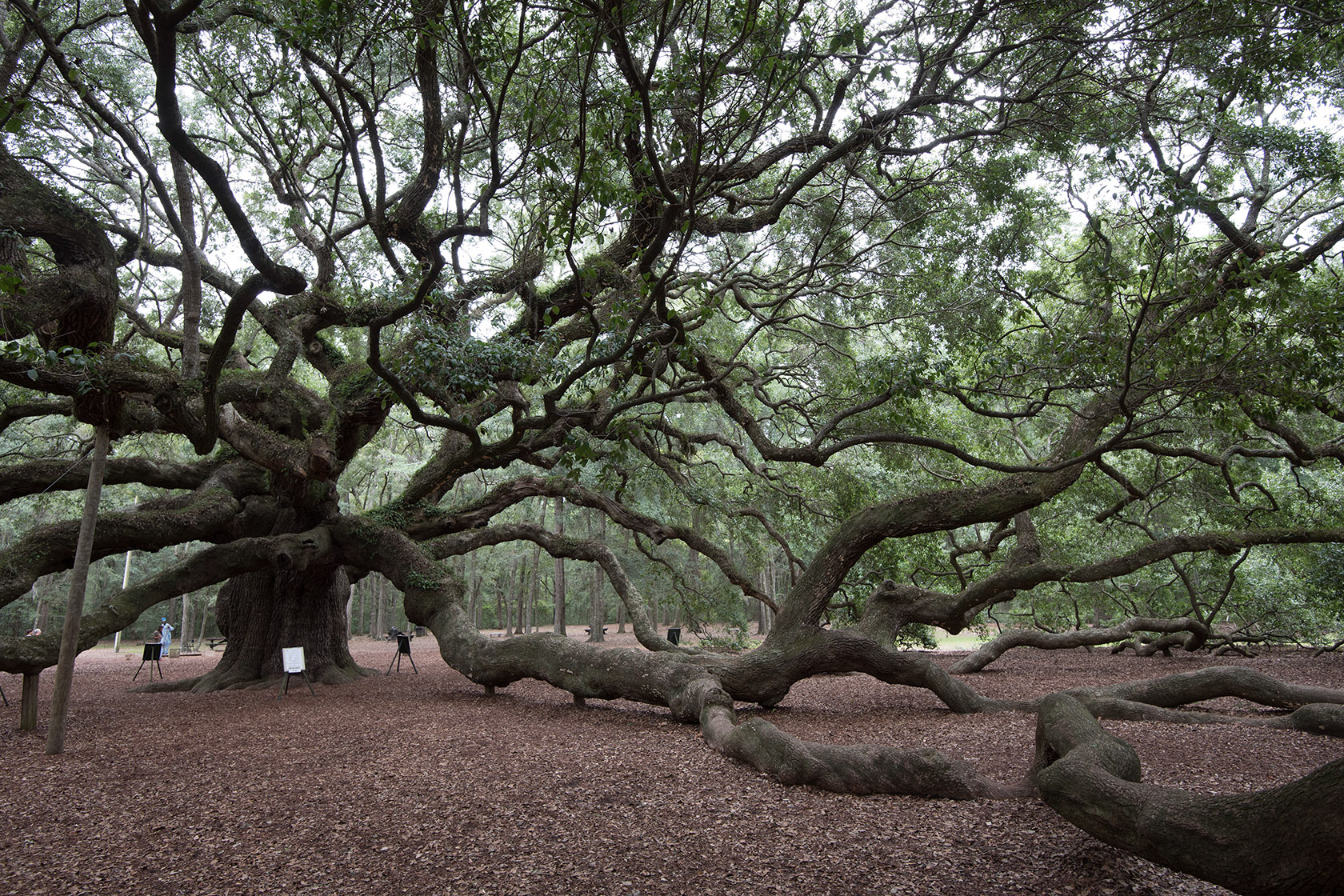
|
Nikon D750 16-35mm f/4.0 lens @ 19mm f/8 1/50 ISO 400 RAW |
This is the image the way it came out of the camera. Note the bright white sign in front and the two signs on either side of the trunk. In addition, there is a person wearing pale blue in the background. All these details take away from the main subject. Removing them allows the viewer to focus on what this photograph is about, i.e., Angel Oak.
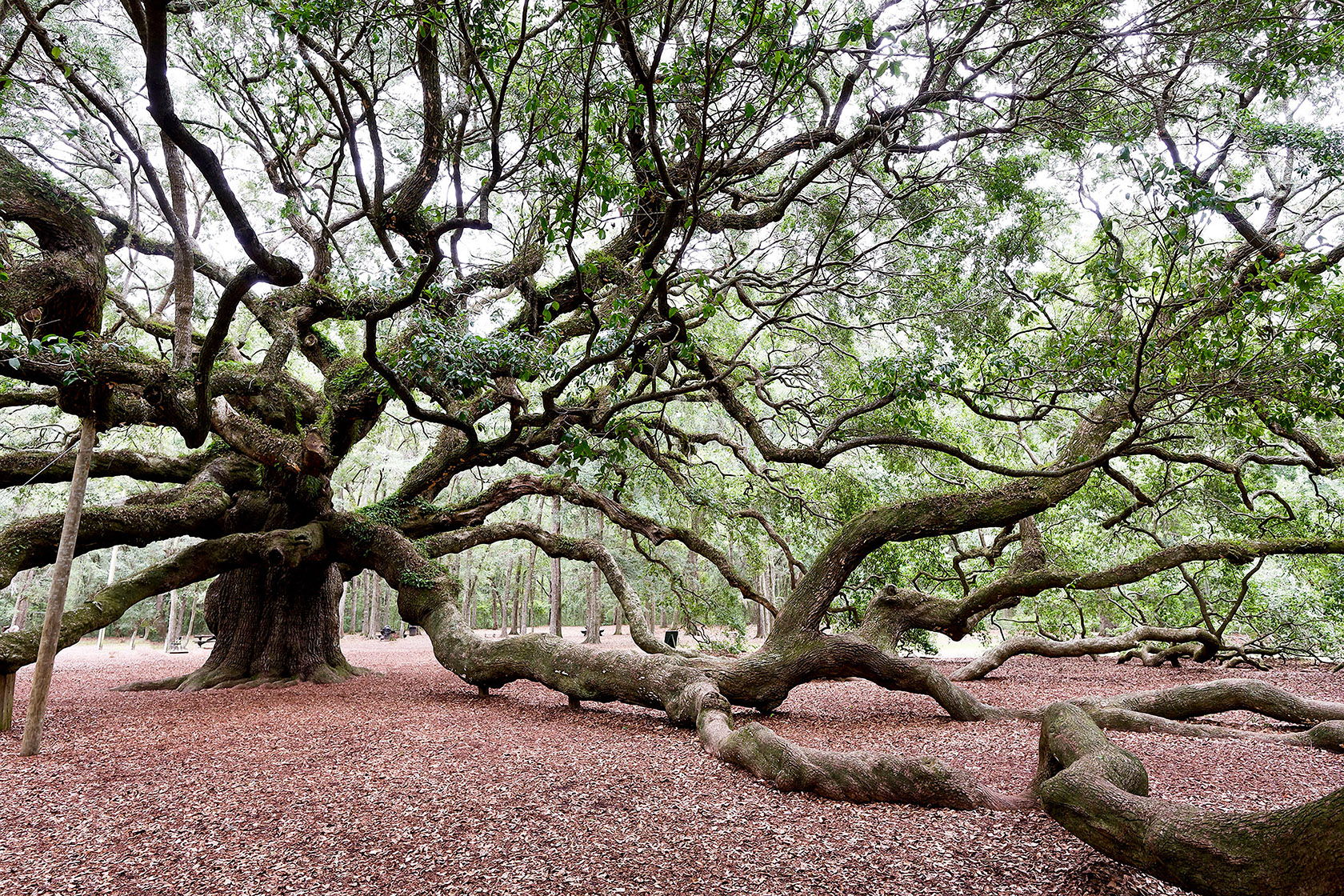
|
Note that in addition to removing unwanted elements, post processing allowed adjusting color and exposure as well as leveling the photograph.
4. Was the sea really that color?
I get this a lot in different variations. Was the sky this blue? Where these poppies that red? The foliage so lush? In a way, it's a variant of the altering reality kind of post processing, but one that changes color, hue, and brightness levels instead of altering physical picture elements. As an example, I shall use a JPEG photo taken in Cannes in January of 2018 with my iPhone. There was a lot of wind, and the Mediterranean looked more like an ocean than a sea. I was struck by the green hues in the water and the interesting sky, so I grabbed my iPhone and took the picture.
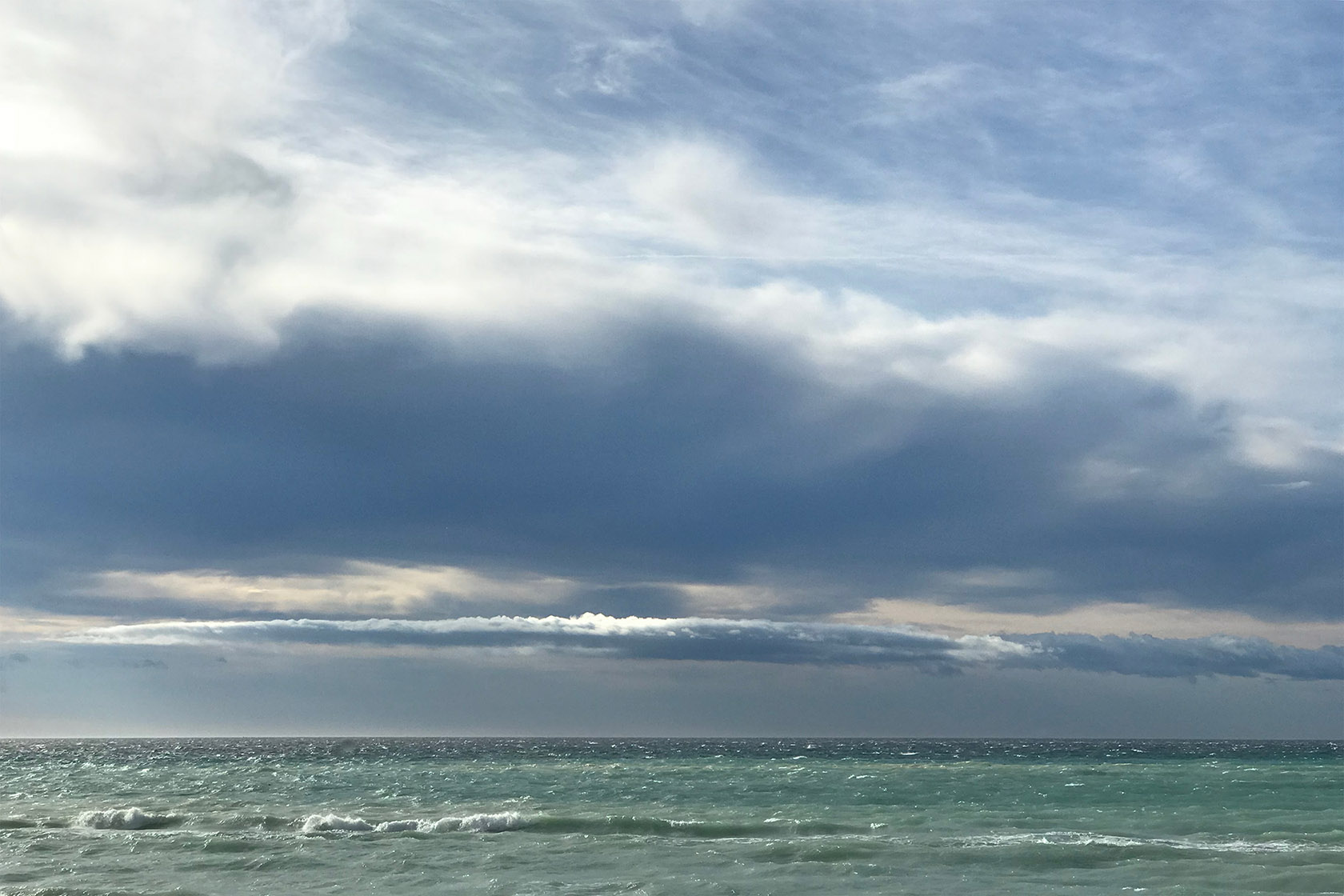
|
Apple iPhone 7 Plus back dual camera 6.6mm f/2.8 lens (57mm in 35mm equivalent) f/2.8 1/2500 ISO 20 JPEG |
The raw converter in the iPhone did a credible job rendering the scene; nevertheless, I was disappointed when I looked at this image because it lacked the drama I thought I had seen and wanted to get across. I adjusted the colors, increased saturation and contrast, and obtained the result shown below. So, was this the color of the sea? I don't know, but it's the way I remember it. How can several people perceive the colors in a scene the same way, let alone remember then identically? Because I am not photographing items for sale in a catalog, in which case there would be a contractual obligation to get the color exactly right, I reserve the right to represent the colors as I see fit—and you should, too!
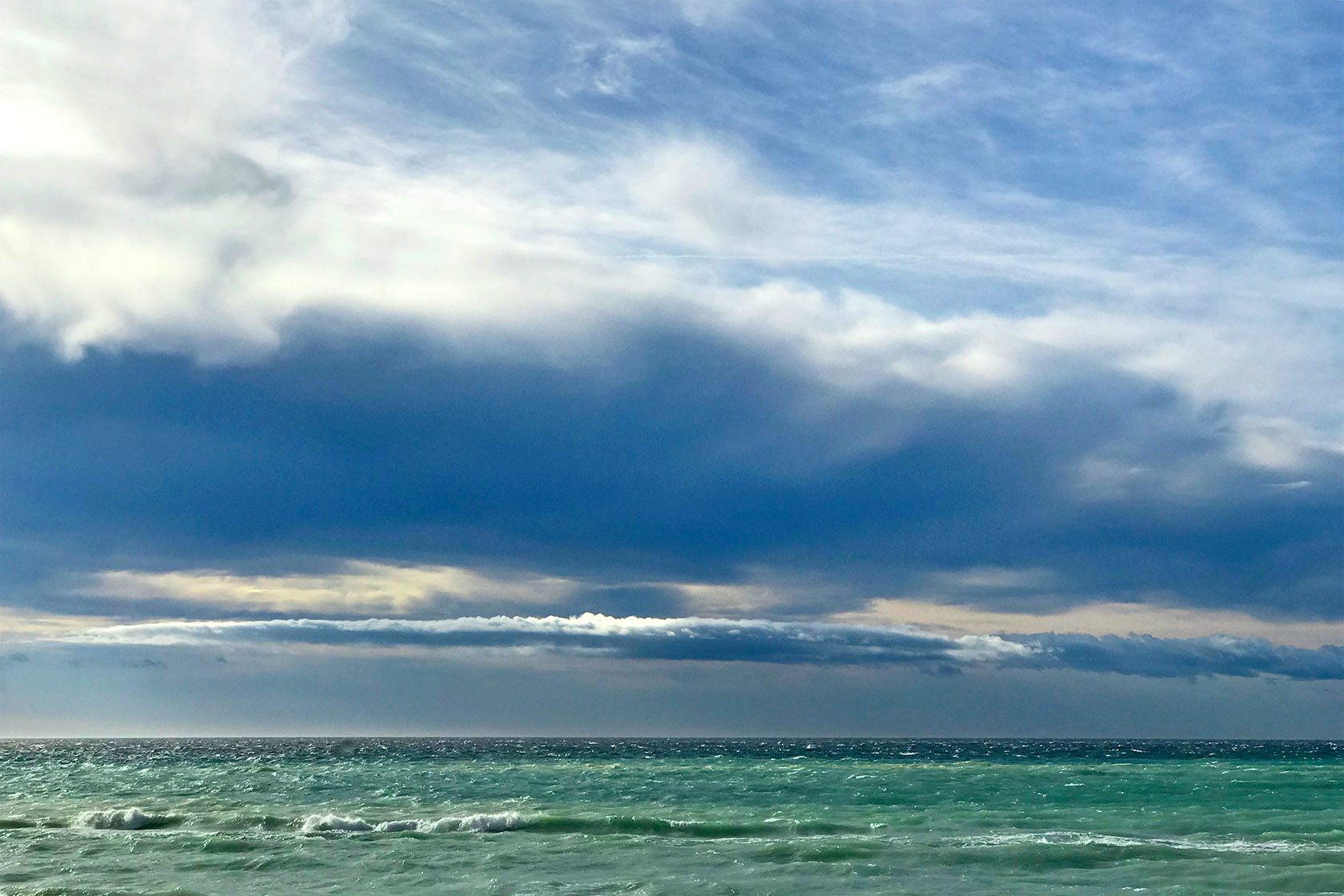
|
Whether or not you like my versions of any of these images better than what came out of the camera is absolutely irrelevant; the point is simply that the final image should be the expression of the photographer's vision, and not the result of some preset one-size-fits-all algorithm cooked up by some technician. Let's look at one more example based on an out-of-camera JPEG:
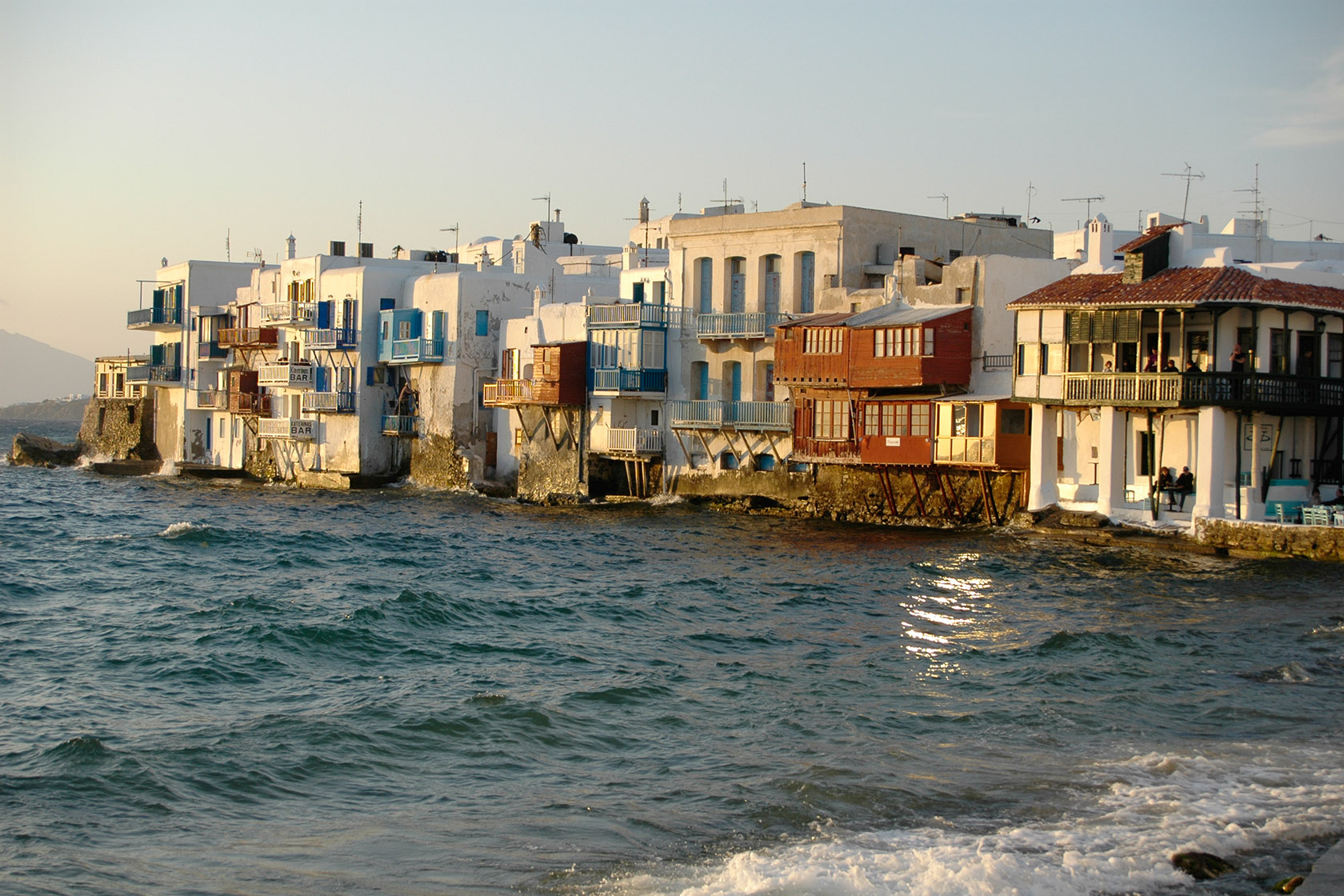
|
Nikon D70 18-50mm f/3.5-5.6 lens @ 42mm (63mm in 35mm equivalent) f/7.1 1/200 ISO 200 JPEG |
The above photograph was taken in the harbor of Mykonos at about 6:30 p.m. in late April of 2004. Again, as you can see, the raw converter in the D70 did a pretty good job of giving us a usable photo out of camera. In this case, post processing served to straighten the photo (because I failed to hold the camera perfectly level when taking the picture), and the slight adjustment to hue and crispness is purely a matter of taste. The finished result looks like this:
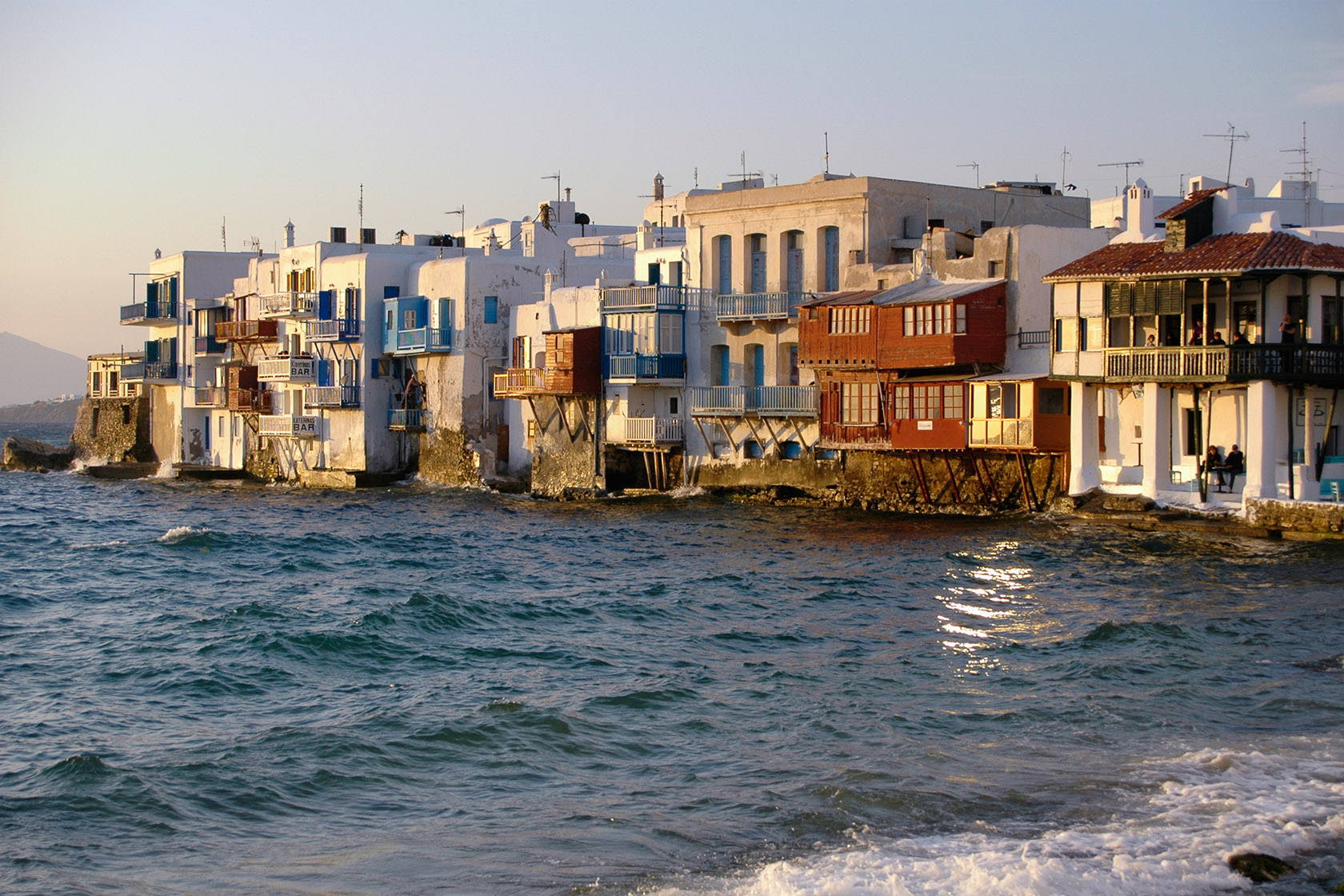
|
To what extent you engage in post processing depends on what you wish to get across. As explained above, when I photograph, I have an idea of what I want the finished photograph to look like. The challenge, then, is to take a picture that contains all the information needed to arrive at the target image in post processing. For example, in the case of the first example, I purposely underexposed the image. Why? Because it is far easier to recover details from shadows than from highlights. Exposing normally would in all likelihood have blown out the highlights to the point where no detail could have been recovered. As it is, details were retained in both shadow and highlight areas.
What you can take away from the admittedly simplified information presented on this page is this: anyone engaging in digital photography and intent on avoiding post processing completely should be using a bridge or simple point-and-shoot camera and rely on its raw converter to produce usable JPEG images. As shown above, out of camera JPEGs can be quite good. Using a dSLR and shooting in raw without post processing is, as Rowan Atkinson famously said in the wonderful Blackadder series, like a broken pencil: pointless.
Home | Site Info | Family | The Area | Trips | France | Work | Rants | Photography | Odds & Ends
This page was last modified on March 1, 2018
Send feedback about this page to feedback@kiechle.com
https://www.kiechle.com/photography/postprocessing/index.htm
(optimized for Retina display)
All contents © 1999-2025 The Kiechles